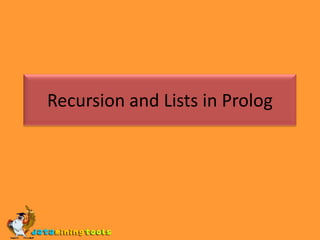
PROLOG: Recursion And Lists In Prolog
- 1. Recursion and Lists in Prolog
- 2. OVERVIEW Recursive definitions Clause ordering, goal ordering, and termination. Lists Members Recursing Down Lists
- 3. Recursive definitions A predicate is recursively defined if one or more rules in its definition refers to itself. Ex: is_digesting(X,Y) :- just_ate(X,Y). is_digesting(X,Y) :- just_ate(X,Z), is_digesting(Z,Y). just_ate(mosquito,blood(john)). just_ate(frog,mosquito). just_ate(stork,frog). It's just a knowledge base containing two facts and two rules. But the definition of the is_digesting/2 predicate is recursive.
- 5. Clause ordering, goal ordering, and termination Consider the following ex: child(martha,charlotte). child(charlotte,caroline). child(caroline,laura). child(laura,rose). descend(X,Y) :- child(X,Y). descend(X,Y) :- child(X,Z), descend(Z,Y). We'll make two changes to it, and call the result descend2.pl: child(martha,charlotte). child(charlotte,caroline). child(caroline,laura). child(laura,rose). descend(X,Y) :- descend(Z,Y), child(X,Z). descend(X,Y) :- child(X,Y).
- 6. we have merely reversed the order of the two rules, and reversed the order of the two goals in the recursive clause. So, viewed as a purely logical definition, nothing has changed. But the procedural meaning has changed dramatically. For example, if you pose the query descend(martha,rose). you will get an error message (`out of local stack', or something similar). Because descend1.pl and descend2.pl are Prolog knowledge bases with the same declarative meaning but different procedural meanings: from a purely logical perspective they are identical, but they behave very differently.
- 7. The declarative and procedural meanings of a Prolog program can differ, when writing Prolog programs you need to bear both aspects in mind. When you need to think about how Prolog will actually evaluate queries. The following questions must be considered: Are the rule orderings sensible? How will the program actually run?
- 8. Lists lists, an important recursive data structure widely used in computational linguistics. It is a finite sequence of elements. Here are some examples of lists in Prolog: [mia, vincent, jules, yolanda] [mia, robber(honey_bunny), X, 2, mia] [] [mia, [vincent, jules], [butch, girlfriend(butch)]] [[], dead(zed), [2, [b, chopper]], [], Z, [2, [b, chopper]]]
- 9. Lists We can specify lists in Prolog by enclosing the elements of the list in square brackets(that is, the symbols [ and ]). The elements are separated by commas. All sorts of Prolog objects can be elements of a list and the same item may occur more than once in the same list. The empty list(as its name suggests) is the list that contains no elements. lists can contain other lists as elements. Any non-empty list can be thought of as consisting of two parts: the head and the tail. The head is simply the first item in the list; the tail is everything else.
- 10. Members Member is a fundamental Prolog tool for manipulating lists, and to introduce the idea of recursing down lists. consider a program that, when given as inputs an arbitrary object X and a list L, tells us whether or not X belongs to L. The program that does this is usually called member. Here it is: member(X,[X|T]). member(X,[H|T]) :- member(X,T). one fact (namely member(X,[X|T])) and one rule (namely member(X,[H|T]) :- member(X,T)). But note that the rule is recursive (after all, the functor member occurs in both the rule's head and tail)
- 11. Members Suppose we posed the following query: ? -member(yolanda,[yolanda,trudy,vincent,jules]). Prolog will immediately answer `Yes'. Because it can unify yolanda with both occurrences of X in the first clause (the fact) in the definition of member/2, so it succeeds immediately.
- 12. Recursing Down Lists Member works by recursively working down a list, doing something to the head, and then recursively doing the same thing to the tail. Recursing down a list (or indeed, several lists) in this way is extremely common in Prolog. When working with lists, we often want to compare one list with another, or to copy bits of one list into another, or to translate the contents of one list into another, or something similar. Ex: Let's suppose we need a predicate a2b/2 that takes two lists as arguments, and succeeds if the first argument is a list of as, and the second argument is a list of bs of exactly the same length. If we pose the following query a2b([a,a,a,a],[b,b,b,b]). we want Prolog to say `yes'.
- 13. Recursing Down Lists If we pose the query a2b([a,a,a,a],[b,b,b]) or the query a2b([a,c,a,a],[b,b,5,4]). we want Prolog to say `no'. For longer lists, think recursively. So when should a2b/2 decide that two non-empty lists are a list of as and a list of bs of exactly the same length?
- 14. Simple: when the head of the first list is an a, and the head of the second list is a b, and a2b/2 decides that the two tails are lists of as and bs of exactly the same length! This immediately gives us the following rule: a2b([a|Ta],[b|Tb]) :- a2b(Ta,Tb). The a2b/2 predicate should succeed if its first argument is a list with head a, its second argument is a list with head b, and a2b/2 succeeds on the two tails. Now, this definition make good sense declaratively.
- 15. Visit more self help tutorials Pick a tutorial of your choice and browse through it at your own pace. The tutorials section is free, self-guiding and will not involve any additional support. Visit us at www.dataminingtools.net